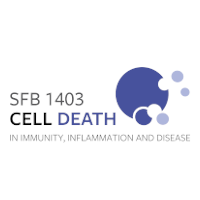A shorter splicing isoform antagonizes ZBP1 to modulate cell death and inflammatory responses
Abstract
Z-DNA-binding protein 1 (ZBP1) is an interferon-inducible sensor of Z-DNA and Z-RNA, which has emerged as a critical regulator of cell death and inflammation. ZBP1 binds Z-DNA and Z-RNA via its Zα domains, and signals by engaging RIPK3 and RIPK1 via its RIP homotypic interaction motifs (RHIMs). Here, we show that mice express an alternatively-spliced shorter ZBP1 isoform (ZBP1-S), which harbours the Zα domains but lacks the RHIMs, and acts as an endogenous inhibitor of the full-length protein (ZBP1-L). Mice and cells expressing only ZBP1-S are resistant to ZBP1-mediated cell death and inflammation. In contrast, cells lacking ZBP1-S show increased ZBP1-L-induced death compared to cells expressing both isoforms. Moreover, loss of the short isoform accelerates and exacerbates skin inflammation induced by ZBP1-mediated necroptosis of RIPK1-deficient keratinocytes, revealing an important physiological role of ZBP1-S. Mechanistically, ZBP1-S suppresses ZBP1-L-mediated cell death by binding to Z-nucleic acids via its Zα domains. Therefore, ZBP1-S acts as an endogenous inhibitor that competes with full-length ZBP1-L for binding Z-nucleic acid ligands to fine-tune ZBP1-mediated cell death and inflammation.
Read more at EMBO J 2024 Sep 19.
